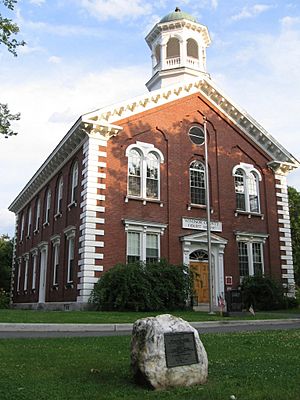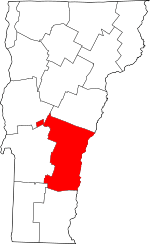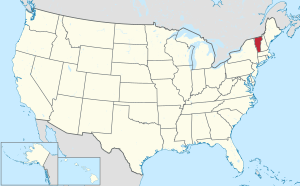Windsor County, Vermont facts for kids
Quick facts for kids
Windsor County
|
|
|---|---|

Windsor County courthouse in Woodstock
|
|

Location within the U.S. state of Vermont
|
|
 Vermont's location within the U.S. |
|
| Country | |
| State | |
| Founded | 1781 |
| Named for | Windsor, Vermont, which was named for Windsor, Connecticut |
| Shire Town | Woodstock |
| Largest town | Hartford |
| Area | |
| • Total | 977 sq mi (2,530 km2) |
| • Land | 969 sq mi (2,510 km2) |
| • Water | 7.4 sq mi (19 km2) 0.8%% |
| Population
(2020)
|
|
| • Total | 57,753 |
| • Density | 59.113/sq mi (22.823/km2) |
| Time zone | UTC−5 (Eastern) |
| • Summer (DST) | UTC−4 (EDT) |
| Congressional district | At-large |
Windsor County is a special area called a county in the state of Vermont. It's located in the United States. In 2020, about 57,753 people lived here.
The main town, or shire town, where the county government is, is Woodstock. The biggest town in Windsor County is Hartford.
Contents
History of Windsor County
Windsor County was created on February 16, 1781. This happened when Vermont decided to become its own state, separate from New York. Before that, the land was part of a bigger area called Cumberland County.
This area has been home to some famous people!
- Calvin Coolidge, who became the 30th U.S. President, was born and buried here.
- Joseph Smith, Jr., who started the Latter Day Saint movement, was also born in Windsor County.
Geography of Windsor County
Windsor County is the largest county in Vermont by size. It covers about 977 square miles. Most of this area is land, with a small part being water.
Neighboring Counties
Windsor County shares its borders with several other counties:
- To the north: Orange County
- To the northeast: Grafton County, New Hampshire
- To the east: Sullivan County, New Hampshire
- To the south: Windham County
- To the southwest: Bennington County
- To the west: Rutland County
- To the northwest: Addison County
Special Natural Areas
You can find parts of these important natural and historical places in Windsor County:
- Green Mountain National Forest
- Marsh-Billings-Rockefeller National Historical Park
- White Rocks National Recreation Area
Main Roads
Many important roads run through Windsor County, helping people travel around. These include major highways like:
People of Windsor County
The population of Windsor County has changed a lot over the years. In 1790, there were about 15,740 people. By 2020, the population had grown to 57,753 people.
In 2010, there were 56,670 people living in the county. Most people were white (96.3%). About 1.2% of the population was of Hispanic or Latino background. The average age of people in the county was about 45.8 years old.
The average income for a family in the county was around $63,387.
Transportation in Windsor County
Windsor County has many important roads. In 2009, it had the most "major arteries" (main roads) in the entire state of Vermont.
One of these roads, US Route 4, feels a bit like a fast highway. Because of this, people sometimes drive too fast. To keep everyone safe, the local police often give out tickets to drivers who are speeding.
Towns and Communities
Windsor County is made up of many different towns and smaller communities.
Towns
- Andover
- Baltimore
- Barnard
- Bethel
- Bridgewater
- Cavendish
- Chester
- Hartford
- Hartland
- Ludlow
- Norwich
- Plymouth
- Pomfret
- Reading
- Rochester
- Royalton
- Sharon
- Springfield
- Stockbridge
- Weathersfield
- West Windsor
- Weston
- Windsor
- Woodstock (This is the main county town!)
Villages
These are smaller parts of the towns listed above:
Census-Designated Places
These are areas that the government counts separately, but they are still part of the larger towns:
- Ascutney
- Bethel
- Cavendish
- Chester
- Hartford Village
- Hartland
- North Hartland
- North Springfield
- Norwich
- Proctorsville
- Quechee
- Rochester
- South Royalton
- South Woodstock
- Springfield
- West Woodstock
- Weston
- White River Junction
- Wilder
- Windsor
Other Communities
- Brownsville
- Felchville
- Gaysville
- Hartland Four Corners
- Lewiston
- North Pomfret
- Plymouth Notch
- Weathersfield Bow
- West Hartford
See also
 In Spanish: Condado de Windsor para niños
In Spanish: Condado de Windsor para niños

